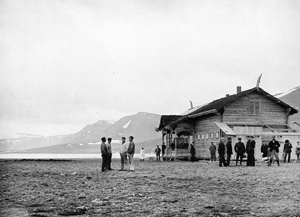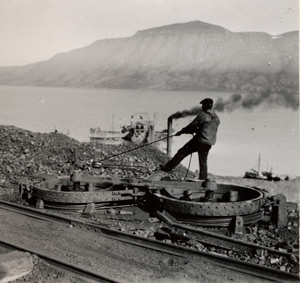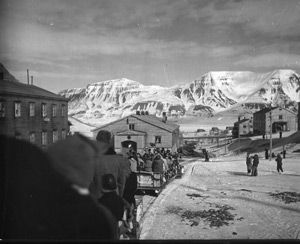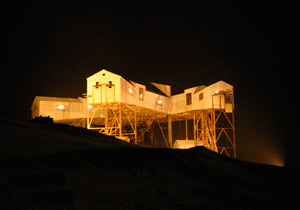|
|
Longyearbyen
[78° 14' N 15° 30' E]
By Øystein Overrein (ed.), Jørn Henriksen, Bjørn Fossli Johansen, Kristin Prestvold
Longyearbyen is the administrative centre of Svalbard. The town hosts a broad range of public services, shops and cafés. Longyearbyen has changed from being a one-sided industrial settlement into becoming a multi-sided community where tourism and science have gained central roles. Longyearbyen is a good starting point for activities in the Isfjorden area.
Take care:
- Do not go outside the town without being armed against polar bears. Recommended boundaries are at the end of the road in Longyeardalen (in Nybyen or “Huset”), at the first dog pen on the road towards Adventdalen and at the airport in the direction Bjørndalen. In winter it is not recommended to walk further than to “Bykaia” (the town wharf) without a weapon for protection. (Make sure you know how to use the weapon.)
- It is common practice to take outdoor shoes off indoors, also in some public buildings.
- Keep a good distance from the reindeers that feed on the grass in between the houses.
- Installations from the early days of mining are protected cultural remains, such as trestles (support framework for coal transport), mining entrances and buildings.
 Before coal mining started, tourism was established in Adventfjorden. This hotel was placed at Hotellneset, close to today’s airport. The hotel was pre-fabricated in Trondheim and shipped to Svalbard in June 1896 with the steamship “Raftsund”. The entrepreneur was Richard With who ten years earlier had established the regular ship service along the Norwegian coast; Hurtigruten (the Coastal Steamer). (Spitsbergen Gazette, no. 8). (Image: Wilh. Dreesen / The Norwegian Polar Institute) Before coal mining started, tourism was established in Adventfjorden. This hotel was placed at Hotellneset, close to today’s airport. The hotel was pre-fabricated in Trondheim and shipped to Svalbard in June 1896 with the steamship “Raftsund”. The entrepreneur was Richard With who ten years earlier had established the regular ship service along the Norwegian coast; Hurtigruten (the Coastal Steamer). (Spitsbergen Gazette, no. 8). (Image: Wilh. Dreesen / The Norwegian Polar Institute)
 Longyearbyen around 1920. (Image: Wilhelm Solheim / Norwegian Polar Institute) Longyearbyen around 1920. (Image: Wilhelm Solheim / Norwegian Polar Institute)
“The enterprise of developing a new and practically unknown coal-field within eight hundred miles of the North Pole, yet so accessible during the summer months and so readily worked during the long Arctic winter as to supply at least part of the demand of the Scandinavian countries and of north western Russia, was an interesting and satisfactory experiment.”
-John Munroe Longyear, in his introduction to America in Spitsbergen: The Romance of an Arctic Coal Mine (1922)
 Bremsaren. Fra kullstransport mellom gruva og kaia 1918. (Image: The Norwegian Polar Institute) Bremsaren. Fra kullstransport mellom gruva og kaia 1918. (Image: The Norwegian Polar Institute)
 From ”Nybyen” around 1950. Transportation of people in sleighs pulled by weasels, (Image: The Norwegian Polar Institute) From ”Nybyen” around 1950. Transportation of people in sleighs pulled by weasels, (Image: The Norwegian Polar Institute)
 The old cable car central at Skjæringa. (Image: Ann Kristin Balto / The Norwegian Polar Institute) The old cable car central at Skjæringa. (Image: Ann Kristin Balto / The Norwegian Polar Institute)
The prelude to the mining industry in Longyearbyen started in 1900 when Trondheim businessmen occupied the prospects in Longyeardalen. Kullkompagniet Trondhjem-Spitsbergen was established. The owners of the company never really dared go after coalmining and were soon looking for suitors to whom they could sell the prospects.
In 1905 a sales agreement was sealed with the American businessmen John Munroe Longyear and Frederick Ayer. They established The Arctic Coal Company (ACC) in 1906. The company developed and operated the mine and a small community grew up around the industry. “Longyear City” held only a few hundred people. The workers were recruited from Norway and Sweden while the functionaries were mostly from England or the USA. The community, run by AAC, was often in a state of unbalance due to the workers’ dissatisfaction, which lead to frequent strikes. Living conditions were primitive, hygiene was poor because of scarce water resources and the food was bad. The food situation was especially bad in spring, before new supplies would arrive by sea with the first ship. But the workers kept on going mainly because of the relatively high salary.
AAC operated the mine until 1915, a period in later years referred to as the “American Era”. In 1916 AAC and all the American properties were sold to Norwegian interests and the name of the company was changed to Store Norske Spitsbergen Kulkompani (SNSK). The settlement was renamed Longyearbyen. In the following winter about 180 men were working in the mines in Longyearbyen. Together with them a handful of women and children overwintered. Towards 1920 the number of people occupied in the mines increased.
Further into the 20th century the small mining town of Longyearbyen was completely governed and operated by the private SNSK – it was a “company town”. They didn’t only manage the mining, but also the options for living, supplies and communication. The community was not for families, but a male dominated one where its inhabitants lived in worker barracks. For the vast majority of the employees their families were left behind on the mainland. For many this was hard to bear.
Demands for modernization and normalization were not met until the nineteen-sixties. In the seventies the Norwegian State took over the shares of the company in a move towards a more pro-active Svalbard policy. The State also took over the management of Longyearbyen and it was decided that, with limitations, it was to become a family community similar to small towns and villages in mainland Norway.
In 1975 the airport was opened and with it a possibility of a year-round communication with the outside world. This was a step towards normalization of the community. With planes came newspapers, fresh foods, relatives and friends. Since 1975 Longyearbyen has been through drastic changes. Private houses have now partly replaced company housing. In 2001 the normalization was taken a step further with the establishment of a local democratic body and political elections.
Up until 1990 Longyearbyen was mainly a mining town. The place has developed into a community with a variety of industries like tourism, science and higher education. These are the pillars in today’s Longyearbyen, together with the mining industry.
In Longyearbyen and its vicinity you find remains from the different mines going all the way to the “American Era”. Most of it is post World War II. Surface installations, transport systems and other installations after the discontinued mining activities are a major part of the landscape all the way to Hotellneset (by the airport) and Adventdalen. The installations are decisive for the identity of Longyearbyen and its cultural environment.
Landing sitesArriving in Longyearbyen by sea you usually go alongside the Bykaia (public quay). The administration building for the harbour houses toilets and showers. The Harbour Master has her office here. At the Bykaia there is a floating dock that can host a limited amount of smaller vessels. It is recommended to pre-order place at the dock in Longyearbyen, as the demand is high in the summer. If there is no space available alongside, you may cast anchor off shore and use a dingy to the floating dock. Recommended trailsFrom the Bykaia you can either walk to the centre or take a taxi. It takes no more than about ten minutes to walk to Svalbard Museum which is co-located with the University Centre in Svalbard, the Norwegian Polar Institute and other institutions in Svalbard Science Centre. At Svalbard Museum you will also find the Tourist Information. On the road from the Bykaia to the town centre you pass the only coal fired power plant in Norway. After passing the power plant you can turn right and end up at Skjæringa where old Longyear City used to be. Here is the office building of the Governor of Svalbard as well as the church and the old cable car central which is an eye-catching building. From Svalbard Science Centre it is easy to find your way to the small centre of Longyearbyen where services such as bank, post office, ATM, public phone, shops and cafés are located.
|
The Cruise Handbook is also available in book form
Order now
Hard cover with numerous pictures - 249 pages - NOK 249.00
Norwegian Polar Institute
Fram Centre
NO-9296 Tromsø
NORWAY
|